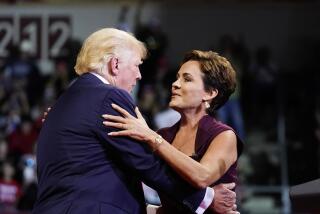Op-Ed: Despite dwindling numbers, Big Labor has a winning new strategy
With the signing into law Monday of a $15 minimum wage in both California and New York, American unions — more particularly, the Service Employees International Union — have demonstrated that they’ve found a new way to bargain on workers’ behalf. Blocked by dysfunctional labor laws from organizing workers on the job, they’ve become adept at winning victories for them through the political process.
When SEIU and a band of 200 New York City fast-food workers began the Fight for 15 in 2012, their goal was to unionize the sector, beginning with the industry giant, McDonald’s. That goal is as elusive today as it was then, but the campaign has nonetheless begun to transform the lives of millions of low-wage workers.
It proved easier to win a significant raise for 100,000 Seattle workers than to unionize 4,000 workers at the city’s airport.
How a movement to help workers join a union became a movement to raise their wages through legislation and at the ballot box is best illustrated by the campaign’s first $15 victory. In 2013, seeking to organize 4,000 workers at the Seattle airport, SEIU countered management’s opposition to recognizing a union by placing an initiative on the ballot that raised the local minimum wage to $15 in Sea-Tac, the suburb where the airport is located. The union’s goal was simply to pressure management to permit the workers to organize, but when management refused, the union went ahead with the initiative campaign and won. The Sea-Tac campaign coincided with municipal elections in Seattle proper; candidates for mayor and City Council backed the $15 standard for the much larger city, and in 2014, they enacted an ordinance that did just that.
It proved easier to win a significant raise for 100,000 Seattle workers than to unionize 4,000 workers at the city’s airport — with whom management has yet to sit down at the bargaining table.
On the job, worker power has dwindled relentlessly. Although unions represented roughly a third of American workers in the postwar decades, today, with workers’ legal protection so weak they are routinely fired if they seek to organize, unions represent just 11% of the workforce, and just 6.6% of the private sector.
In the political sphere, however, unions punch above their weight. They’ve become expert at turning out the vote not just of their members at election time, but also of thousands of voters who don’t belong to unions. It was through just such an exercise of political clout, by qualifying an initiative for the November ballot that would have raised the minimum wage in California to $15, that they persuaded Gov. Jerry Brown and the Legislature to enact such a measure themselves.
But there’s a limit to how much unions can win politically if they continue to shrink. The 9 million workers who will get raises as a result of the two states’ new laws are the beneficiaries of a far smaller group of workers who were able, some years back, to unionize, and whose power, aggregated through their unions, was still sufficient to get these new laws passed. While those 9 million workers have gained income and better lives, they have not amassed power that they can use on their own and others’ behalf.
Perhaps the best unions can do for now is to win political victories, to secure governmental requirements for incomes and benefits that they once secured through contracts with management. This strategy may become even more necessary as American employers abandon the very concept of the traditional job (and with it, their responsibility for providing their workers with a fair share of the proceeds from their labor).
A new study by economists Lawrence Katz of Harvard and Alan Krueger of Princeton documents that between 2005 and 2015, the net number of workers employed in “alternative jobs” — temps, independent contractors, on-call workers and subcontracted workers — increased by 9.4 million, while the net number workers in traditional standard employment arrangements declined by 400,000. If traditional jobs are vanishing, organizing workers becomes all the more difficult.
The enactment of the new $15 standard is a tribute to unions’ ingenuity and tenacity — and precisely those qualities are required to find ways to organize this new employee-and-non-employee workforce. Prompted by some particularly creative unions, Seattle recently broke new ground by extending collective bargaining rights to independent contractors in personal transit (Uber, Lyft and cab drivers). It will take many such statutes and a good deal else to rebuild the worker power than once created a vibrant American middle class.
Harold Meyerson is executive editor of the American Prospect.
Follow the Opinion section on Twitter @latimesopinion and Facebook
More to Read
A cure for the common opinion
Get thought-provoking perspectives with our weekly newsletter.
You may occasionally receive promotional content from the Los Angeles Times.






